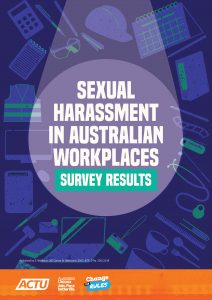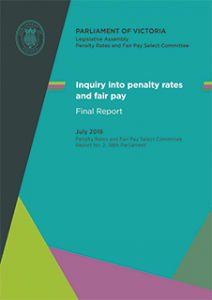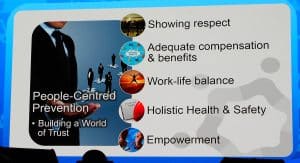Most of the international reporting in June 2021 was about the G7 meeting, but the International Labour Organisation (ILO) also conducted a World of Work Summit as part of its 109th International Labor Conference. Several world leaders recorded messages for the event, and two are particularly interesting – President Joe Biden and Pope Francis. Such statements do have global influence and can support local occupational health and safety (OHS) initiatives.
Category: human rights
Selective duty of care being applied by the Australian Government – from the archive
Yesterday’s article on Comcare’s recent charging of two organisation over workplace-related harm to others generated so much interest that I have (re)published an article from 2016 that analysed an earlier, similar issue. Please also read the comments below and consider adding your own.
Australia’s work health and safety (WHS) laws confirmed the modern approach to workplace safety legislation and compliance where workers and businesses are responsible for their own safety and the safety of others who may be affected by the work. The obligations to others existed before the latest WHS law reforms, but it was not widely enforced. The Grocon wall collapse in Victoria and the redefinition of a workplace in many Australian jurisdictions through the OHS harmonisation program gave the obligation more prominence but has also caused very uncomfortable challenges for the Australian government – challenges that affect how occupational health and safety is applied in Australian jurisdictions.
Continue reading “Selective duty of care being applied by the Australian Government – from the archive”New Zealand leads on wellbeing

A couple of months ago, SafetyAtWorkBlog mentioned New Zealand’s Wellbeing Budget. Last week a representative of the NZ Treasury, Ruth Shinoda, spoke about it from direct experience in Melbourne at the 7th Global Healthy Workplace Summit. The Wellbeing Budget and a complimentary Living Standard Framework provide important contrasts to how Australia is valuing the healthy and safety of its citizens and workers.
If all you have is a hammer, everything looks like a nail
 The trade union movement has often been instrumental in affecting and sometimes creating government policy on occupational health and safety (OHS). The latest generation of hazards – psychosocial – can be traced back to a survey late last century of workplace stress conducted by the Australian Council of Trade Unions (ACTU). This week the ACTU released its survey into sexual harassment at work.
The trade union movement has often been instrumental in affecting and sometimes creating government policy on occupational health and safety (OHS). The latest generation of hazards – psychosocial – can be traced back to a survey late last century of workplace stress conducted by the Australian Council of Trade Unions (ACTU). This week the ACTU released its survey into sexual harassment at work.
The current survey should not be seen as representative of any social group other than trade union members even though the survey was completed by 10,000 of them. Also, this survey is far less likely to be as newsworthy as last century’s surveys as the agenda on workplace sexual harassment has already been established by reports from groups like Universities Australia and, especially, the current work by the Sexual Discrimination Commissioner and the Australian Human Rights Commission. It is also likely to be covered, probably as a secondary issue, in the various mental health inquiries scheduled for 2019.
The ACTU survey provides additional information to our understanding of sexual harassment at work but certainly not the whole picture.
Industrial Manslaughter is more than just a law, it is a cry for justice.
 For those Australians who are watching the latest political push for Industrial Manslaughter laws, it is important to remember that the activity has a history that extends over a decade. Many of the current arguments for and against have been addressed previously. In August 2004, the earlier iteration of this blog, Safety At Work magazine, printed a special edition on “The Australian Industrial Manslaughter Debate”. Below is an edited version of my Editorial in that magazine. A longer article on the issues raised in that edition is available elsewhere in the SafetyAtWorkBlog.
For those Australians who are watching the latest political push for Industrial Manslaughter laws, it is important to remember that the activity has a history that extends over a decade. Many of the current arguments for and against have been addressed previously. In August 2004, the earlier iteration of this blog, Safety At Work magazine, printed a special edition on “The Australian Industrial Manslaughter Debate”. Below is an edited version of my Editorial in that magazine. A longer article on the issues raised in that edition is available elsewhere in the SafetyAtWorkBlog.
Not even lip service to OHS
 Australia currently has a lot of official inquiries into workplace issues that affect the occupational health and safety (OHS) of workers. It is almost impossible to keep up with them and, as a result, some important voices are being missed, but even if they spoke, there is a strong chance they will not be listened to. The Victorian Government has released the final report of the Inquiry into Penalty Rates and Fair Pay. There are two overt mentions of OHS that don’t seem to go anywhere.
Australia currently has a lot of official inquiries into workplace issues that affect the occupational health and safety (OHS) of workers. It is almost impossible to keep up with them and, as a result, some important voices are being missed, but even if they spoke, there is a strong chance they will not be listened to. The Victorian Government has released the final report of the Inquiry into Penalty Rates and Fair Pay. There are two overt mentions of OHS that don’t seem to go anywhere.
In a submission quoted by the Inquiry, the
People Centred Prevention should not be a new concept
 The World Congress on Safety and Health is physically and mentally exhausting. Physically, simply because of its size. Mentally because there is so much information. Some that confirms your occupational health and safety (OHS) approach and others that conflict with what you know. Some information that seems incredibly dated and anachronistic but you look around and this seems new and wonderful to other delegates.
The World Congress on Safety and Health is physically and mentally exhausting. Physically, simply because of its size. Mentally because there is so much information. Some that confirms your occupational health and safety (OHS) approach and others that conflict with what you know. Some information that seems incredibly dated and anachronistic but you look around and this seems new and wonderful to other delegates.
A major theme of the Congress was “People Centred Prevention” (PCP). This is one of the anachronisms. Wasn’t OHS always about keeping people safe? If this theme had originated in the United Kingdom, it could have been contextualised as redressing the red tape attack on OHS regulation by previous governments – bringing the humanity back to OHS – but it is being proposed in this Congress as a significant change of focus and perspective.

